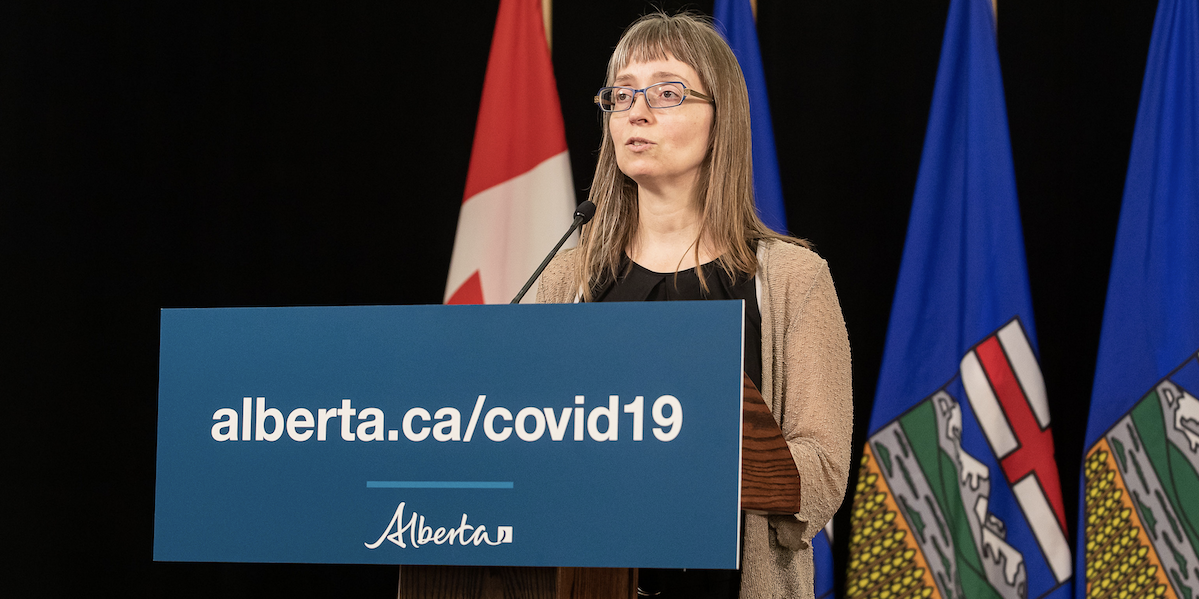Just to be perfectly clear, Alberta Chief Medical Officer of Health Deena Hinshaw’s $227,911 in “cash benefits” is not overtime and should not be called overtime.
Call it a cash bonus if you like, although someone in the United Conservative Party (UCP) government must have reckoned that terminology would have opened the door to the argument that, compared to other top Canadian public health officials, Hinshaw doesn’t seem to have done a stellar job during the pandemic. Readers will recall the times when Alberta led the nation in COVID-19 infections and deaths.
The overtime characterization may have begun when Steve Buick, press secretary to Health Minister Jason Copping, told a reporter that Hinshaw’s huge bonus, the equivalent of 63 per cent of her base salary, was calculated on her base hourly rate of pay and the number of hours she worked beyond 45 each week.
This has not been particularly helpful to the government’s case because, as many annoyed health care workers quickly noted, at the same time as then finance minister Travis Toews was planning to give Hinshaw a huge raise, he was telling the public that nurses and other health care workers deserved a pay cut.
Toews is now a candidate to replace Jason Kenney as premier and UCP leader.
With wards too busy for them to take breaks, rampant understaffing and a doctor shortage sending thousands of Albertans to Emergency Rooms for primary care, Alberta’s nurses work untold hours of unpaid overtime every year.
If Hinshaw deserved a rich bonus for her overtime work, strain and risk during the pandemic, then surely so too do the nurses and other health care workers on the front lines of the fight against COVID-19 an its continuing aftermath.
It’s very hard to argue with that logic, although back in the first months of the pandemic, that’s exactly what the UCP was arguing.
So it’s surprising that in the ensuing brouhaha after the revelation of Hinshaw’s huge bonus on Heritage Day so many Albertans seem to have bought the government’s misleading claim that this is just overtime, and therefore acceptable.
Sorry, but no. Practically speaking and in law, supervisors, managers, and employees who deal with confidential matters do not qualify for overtime. That’s why they’re paid the big bucks.
This is true in most Western jurisdictions. The distinction is made in law in Alberta.
Hinshaw is a senior government official, in some ways like a deputy minister, although with extraordinary additional powers to enforce public health regulations – powers that she seems to have deemed appropriate to relinquish to the politicians in the provincial cabinet. We can only speculate as to why.
Be that as it may, on those grounds she would not normally qualify for overtime pay.
The regulations of the Alberta Employment Standards Code state that records of hours of work and overtime hours need not be kept for “an employee who is employed in (i) a supervisory capacity, (ii) a managerial capacity, or (iii) a capacity concerning matters of a confidential nature and whose duties do not, in other than an incidental way, consist of work similar to that performed by other employees who are not so employed.”
Hinshaw meets the definition of all points on this list.
Likewise, it is vanishingly rare for senior employees who work under contract to be paid overtime above and beyond the terms of their contract.
Hinshaw’s contract specifies her generous base salary of $363,634 ($13,985.92 every two weeks) and various other benefits.
If the government has a record of the hours she worked, it must be because she kept it.
If calling Hinshaw’s bonus something it isn’t was intended to blunt the criticism of the payment, it seems to have had the opposite effect.
Elections Alberta says NDP raised nearly triple the Q3 donations of UCP
Elections Alberta released its fundraising disclosures for the third quarter of 2022 yesterday and the NDP appears to have raised close to triple the amount donated to the UCP.
NDP coffers grew by $1,430,146.06 in the second quarter, compared to $521,175.21 for the United Conservative Party.
Of course, certain caveats apply to these figures.
The No. 3 fundraising “party,” once again, was the Pro-Life Alberta Political Alliance, which posted donations of $94,214.98. Arguably, the Pro-Life Party operates as a public anti-abortion and covert candidate-recruitment auxiliary to the UCP, so its donations should be considered partisan contributions to the Conservative party.
In addition, the impact of leadership contenders soliciting donations from UCP supporters will likely have reduced the amount of money flowing directly from donors to the party. But that money too should be considered donations to the UCP and, once the leadership question is settled, some of it will flow back to party coffers.
Finally, as my blogging colleague Dave Cournoyer pointed out yesterday, changes to fund-raising legislation for which the UCP has no one blame but itself mean that funds raised by its constituency associations are not counted till the end of the year.
NDP disclosures, by contrast, show the full amount raised by the Opposition party because that’s the way the NDP keeps its books.
The UCP may have thought ensuring its legislation allowed it to keep its constituency fund-raising secret until the end of the year conveyed some kind of competitive advantage, and perhaps it does, but the effect when it comes to media coverage is to establish the narrative that voters and their money are moving to the NDP because the UCP has been such a disaster.
Just the same, UCP donations must be assumed to be significantly larger than they appear.




